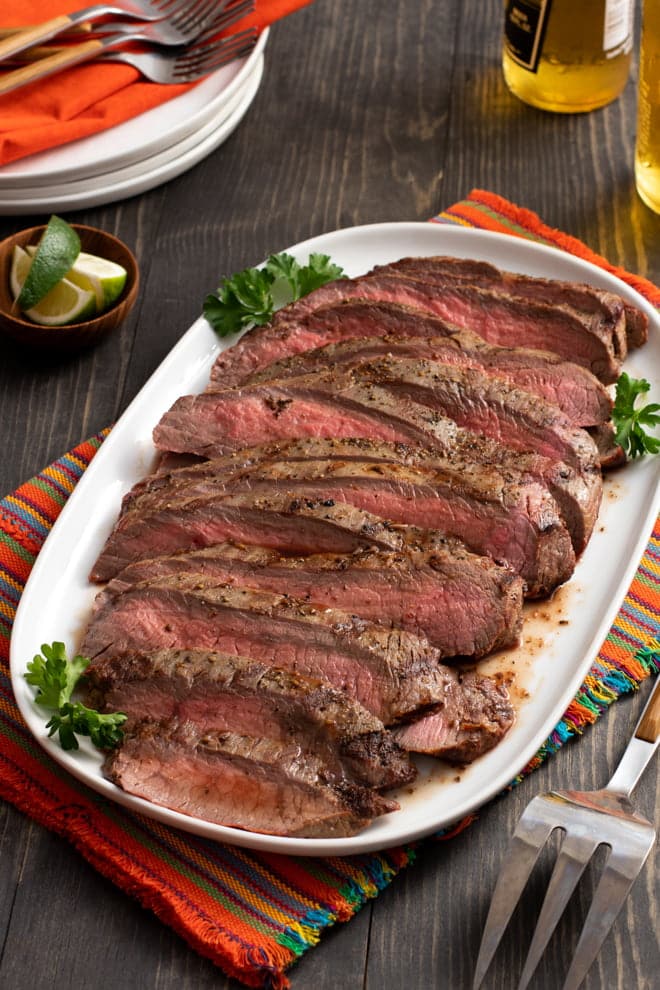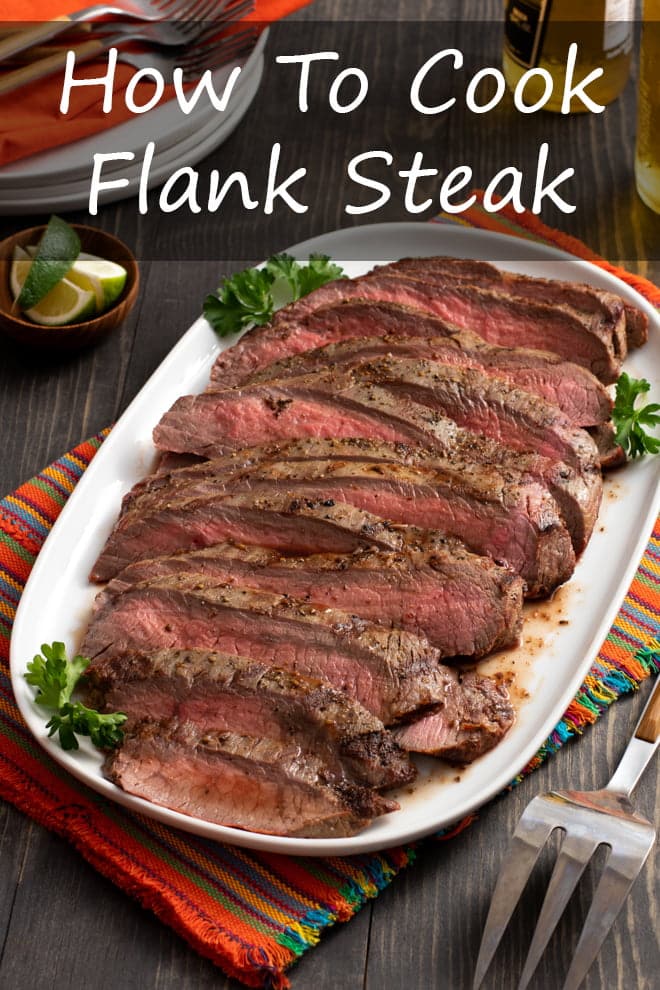Best Way to Cook Beef Flank
This post may contain affiliate links.
Flank steak is a lean, flavorful, inexpensive cut that feeds a crowd in a hurry. Learn how to cook it right, and it'll be juicy perfection every time!
Flank steak is definitely one of my favorite cuts of beef because, like skirt steak—another favorite—it's easy and inexpensive. Better still, it's jam-packed with big beefy flavor.
But there are a few tricks to bringing out the best in flank steak. Ignore them and you risk a steak that's tough and dry. Follow them and you'll have a satisfying meal, in about 15 minutes, every single time.

What Is Flank Steak?
Flank steak is sometimes referred to as a bavette or London broil (which actually refers to a specific way to cook this cut). Though it's lean, without rich marbling, it does have a rich, beefy taste – you just have to cook it right.
It comes from along the abdominal area of the animal, near where the skirt steak comes from. Like skirt steak, it's rectangular shaped and not very thick. But flank steak is a wider at about 8 to 10 inches and little thicker at about 1 inch. They tend to weigh 1 and a half to 3 pounds.
Also like skirt steak, flank steak has a visible grain running through it. But while a skirt steak's grain runs width-wise, a flank's runs lengthwise. The grain looks like stripes of muscle running down the meat, and it comes into play a little later, when it's time to slice your steak.
Cooking Flank Steak
Because flank steak is lean, it can become dry and chewy if overcooked. So go for rare to medium-rare. And because flank steak is relatively thin, it's best to cook it over relatively high heat—so it can develop a flavorful crust on the outside before it's overcooked on the inside.
All in all, that means a flank steak will do best with quick, high-heat cooking methods like grilling, broiling, and pan-searing. I prefer grilling for the easy clean-up, but you can adjust my recipe below for broiling (which is basically upside-down grilling in the oven). I don't tend to pan-sear flank steak because I simply don't have a pan large enough to hold one! But if you have a griddle or something similar, that will absolutely work.
Another trick to getting a good crust—pat your flank steak dry before cooking.
Slicing Tips
Remember the grain in the meat that I mentioned earlier? That graining is long muscle fibers and they can be stringy, chewy, and tough to eat. If, however, you slice your flank steak against that grain—in other words, at a 90° angle to those fibers, or width-wise—you'll be essentially breaking down those long strings before they even get on your plate. Resulting in a more tender eating experience.
Of course, before you do any slicing, you want to let the meat rest for at least 5 minutes. This helps the meat stay juicy, even after it's cut. (This electric knife is my favorite tool for perfect, even slices.)
Enhancing Your Flank Steak
My flank steak recipe below keeps it simple, just seasoning with salt and pepper. But you could absolutely add whatever additional herbs and spices you like. Garlic powder and onion powder would be great. Or chili powder and cumin – that would especially make sense if you're using it for steak fajitas, which is common.
Do I Need To Marinate My Steak?
It's also common to marinate flank steak, which I imagine comes from its perceived toughness (which you now know is mostly just the chewiness of the muscle fibers if they're not sliced right). The truth is, though, that because a marinade doesn't really penetrate much beyond the surface of the meat, it doesn't really tenderize. (Here's a good article about that from Cook's Illustrated.)
That said, a marinade can be a great way to add flavor – to anything from steak to pork chops to chicken. So if you have a favorite, go ahead and use it on your flank steak. It's popular to combine olive oil, soy sauce, lime juice or lemon juice, and some brown sugar for this cut of meat. TheCookful also has a great list of flavor combinations for marinades.
Just don't forget to pat it dry before cooking so you can get that nice crust!
Adding Flavor With Sauces
You can also add flavor after or during the last few minutes of cooking, in the form of a sauce. I like mine brushed with barbecue sauce for the last couple of minutes on the grill. I also enjoy it with salsa or chimichurri at the table.
How To Serve Grilled Flank Steak
In any one of those variations, flank steak is a great main dish served simply with some grilled veggies. But it's also great in tacos, burritos, and sandwiches – all great ways to repurpose any leftovers.
Try to avoid reheating, though, because that can lead to the meat becoming more than medium-rare—in other words, overcooked and dry. Which makes using leftovers for a steak salad a great (and delicious) option.
Enjoy! – Christine
DESCRIPTION
Flank steak is a lean, flavorful, inexpensive cut that feeds a crowd in a hurry. Learn how to cook it right, and it'll be juicy perfection every time! And while it's plenty tasty with just salt and pepper, you can definitely add your favorite herbs and spices, a marinade, or a sauce on the side. With flank steak, it's all good!
-
2 lb. flank steak, about 1 in. thick
-
2 tsp. salt
-
2 tsp. pepper
-
Pat the flank steak dry with paper towels. Sprinkle with the salt and pepper.
-
Prepare a grill for direct cooking over medium-high and lightly oil the grate.
-
When the grate is good and hot, add the steak and cook to an internal temperature of 120°F for rare or 130°F for medium-rare, 4 to 5 minutes per side.
-
Transfer to a cutting board and let rest about 5 minutes.
-
Notice the grain or the stripes running lengthwise in the meat. Thinly slice the steak width-wise, across the grain (at a 90° angle to the stripes), and serve.
This post originally appeared in June 2022 and was revised and republished in April 2022.

Source: https://cookthestory.com/how-to-cook-flank-steak-perfectly/
0 Response to "Best Way to Cook Beef Flank"
Post a Comment